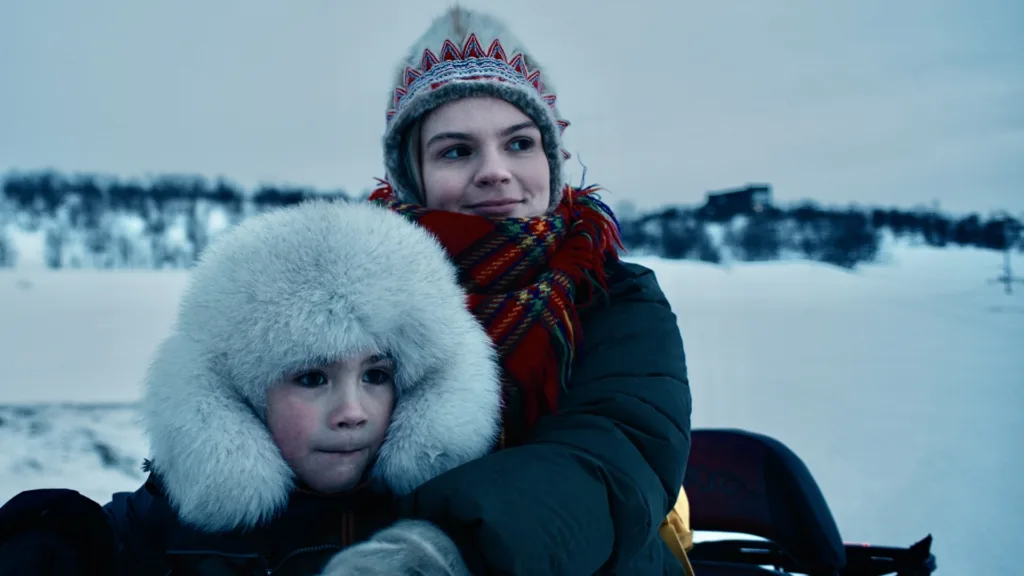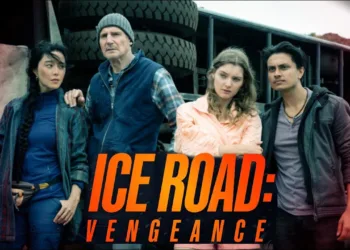To return home is to confront a ghost, and for the artist Lena, that ghost is herself. She arrives in the stark, white expanse of Sápmi with her son, a specter from the southern city of Oslo. Her stated mission is professional: to document the lives of female reindeer herders. Yet the land and its people receive her with the bite of frost. The air is thick with a cold suspicion, a silence that judges her departure and scorns her return.
Every glance reminds her that this place, etched into her bones, no longer claims her. The Tundra Within Me begins here, in this liminal space between belonging and exile, asking a chilling question: what remains of identity when the community that forged it turns its back? It is a quiet, haunting meditation on the self as a territory one can abandon but never truly escape.
The Unforgivable Art of Memory
The central schism of the film is not one of love, but of seeing. Lena’s art is an act of violent memory, a surrealist dreamscape where women’s bodies merge with the skulls and legs of reindeer. To her, these visceral collages of bone and flesh are truth, an excavation of a difficult, gendered experience within the herding life.
To the community, they are a profanity, a public dismembering of sacred tradition, and an unforgivable breach of an unspoken pact of silence. Lena is the insider who became an outsider, and her knowledge makes her betrayal all the more profound. She cannot be dismissed as an ignorant stranger; she knows the land’s deep song, which makes her choice to sing a discordant new verse feel like a calculated act of aggression.
Her very existence poses an unsettling query about authenticity: does it live in the faithful repetition of the past, or in the courage to dissect its hidden wounds? Is a culture a museum piece, or a living body that must scar to heal? Her lover, Máhtte, offers a third way, a path of anxious compromise.
He is a man of the earth who sees virtue in a new snowmobile, a pragmatist who understands that survival sometimes requires new tools. He is drawn to Lena’s foreignness, perhaps seeing in her a reflection of his own desire to evolve without breaking from the immense gravity of his inheritance.
The Weight of Sky, The Gravity of Skin
Against a canvas of blinding snow and immense, indifferent sky, the human drama unfolds with a raw, desperate intimacy. The landscape is no mere setting; it is an active presence, its desolation pressing down on the characters, stretching time into a slow, contemplative rhythm that mirrors their internal stasis
In this emptiness, the romance between Lena and Máhtte feels less like a choice and more like a necessary point of gravity, two people clinging to each other for warmth and validation. Is their connection genuine, or a shared projection born of mutual desperation? The film leaves this question hanging in the frozen air.
Their bond is a testament to the unvarnished performances from Risten Anine Kvernmo Gaup and Nils Ailu Kemi, who convey entire histories in loaded silences. The matriarchs stand as pillars of the old world. Gáren, Máhtte’s mother, is a figure of iron will, yet her tyranny is born of a desperate calculus for survival in a world of shrinking lands and encroaching threats.
Her love is a form of brutal preservation. Likewise, Lena’s mother, Márjá, sees in her grandson’s faltering Sámi language the terrifying prospect of erasure, a fear that her lineage will simply dissolve. The tundra’s oppressive beauty makes their small, human struggles feel both fragile and monumental.
Singing the Land’s Deep Song
As a debut, Sara Margrethe Oskal’s film is an act of profound self-reckoning. A former herder herself, Oskal directs not as an observer but as a participant, mapping the topography of a heritage that is at once a burden and a source of life. The film’s power is in its patient accumulation of details: the mundane, greasy struggle with failing equipment; the spiritual resonance of a joik contest, where Lena reclaims her voice in the most traditional way imaginable; the constant, unspoken threat of herds mixing on shrinking pastures.
These are not plot points; they are the texture of existence, rendered with an unsparing, authentic gaze. The film’s quietness is a deliberate choice, a rejection of frantic pacing for the slow, geological time of the land itself. The editing skillfully blurs the line between the external world and Lena’s interior vision, making her art feel like a rupture in reality.
The film offers no simple resolutions. Instead, it leaves us with the image of a woman caught between worlds, carrying the tundra within her. It suggests that heritage is not a place you can return to, but a landscape you carry inside, a wilderness that continues to grow, beautiful and unforgiving, long after you have left.
“The Tundra Within Me” is a 2023 film that premiered at the Toronto International Film Festival and was also screened at the Seattle International Film Festival in 2024. The story follows Lena, a Sámi artist who returns to her hometown in the Arctic region of Norway with her son. The film delves into the challenges of balancing a modern artistic life with traditional Sámi culture and the importance of community and forgiveness.
Full Credits
Director: Sara Margrethe Oskal
Writers: Sara Margrethe Oskal
Producers: Mona Johanne Hoel
Executive Producers: Mona Johanne Hoel, Anne Margaretha Oskal, Håkon Lammetun, Jakob Bechmann
Cast: Risten Anine Gaup, Nils Ailu Kemi, Elias Ánte Pilutaq Gaup Lennert, Anitta Katriina Suikkari, Berit Anne O. Kemi, Anders Isak Oskal, John Ante Oskal, Aslat Mahtte Gaup, Inga Marja Utsi, Ingá Márjá Sarre, Sverre Porsanger, Egil Keskitalo, Ebba Lovise Joks
Director of Photography (Cinematographer): Anders Hoft
Editors: Anna Løvlund
Composer: Ville Langfeldt, Jakop Janssønn
The Review
The Tundra Within Me
A quiet and hauntingly beautiful film, The Tundra Within Me is a profound meditation on the fracturing of self that occurs when one is caught between tradition and personal expression. It forgoes easy answers, instead immersing the viewer in a landscape as stark and emotionally resonant as its protagonist’s internal conflict. It is a powerful, contemplative piece of cinema that lingers long after the screen goes dark.
PROS
- A deeply authentic and intimate window into Sámi culture and the challenges of herding life.
- Stunning cinematography that makes the vast, desolate landscape a character in itself.
- Powerful, understated performances that convey deep emotional complexity.
- A thought-provoking and philosophically rich exploration of identity, art, and heritage.
CONS
- The deliberate, contemplative pacing may feel slow for some viewers.
- Its refusal to offer simple resolutions might leave some feeling unsatisfied.
- The focus is more on internal, existential struggles than on external plot momentum.














































